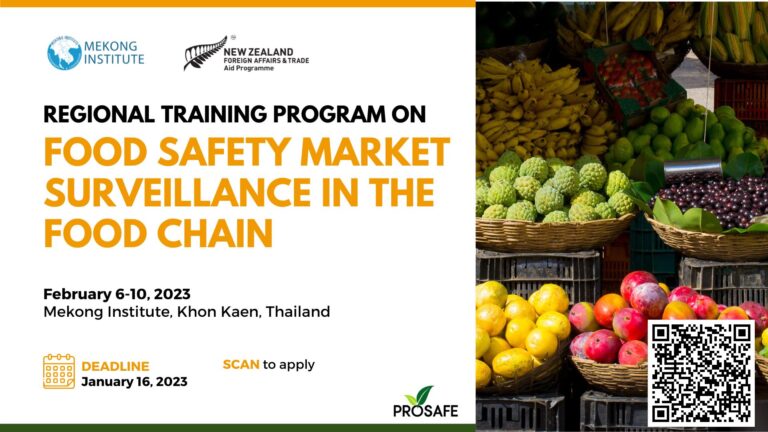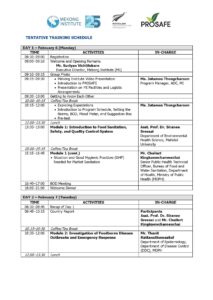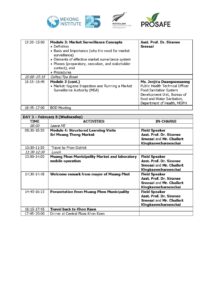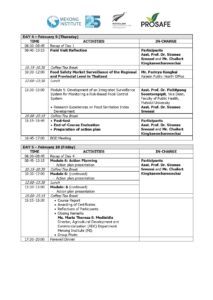

Foodborne diseases comprise a wide spectrum of illnesses that result from ingestion of foodstuffs contaminated with microorganisms or chemicals. Food may become contaminated at any stage in the process from production to consumption, and contamination may be the result of environmental contamination, such as pollution of water, soil or air.
Foodborne diseases are a growing public health problem throughout the world and cause a considerable burden of disability and mortality. WHO studies of the global burden of foodborne diseases in 2010 estimated that 31 hazards (including viruses, bacteria, protozoa, helminths and chemicals) caused 600 million foodborne illnesses globally (95% uncertainty interval (UI) 420–960 million) and 420 000 deaths (95% UI 310 000–600 000) (WHO, 2015). The most common clinical presentation of foodborne disease is gastrointestinal symptoms. Other serious consequences include kidney and liver failure, brain and neurological disorders, reactive arthritis and cancer.
Foodborne diseases are preventable and can be controlled through an effective food safety system that takes account of hazards from the place of production to the point of consumption. The international food trade has expanded and will continue to grow. Food is often exported from one country to another, which means that food contaminated in one country can cause disease in other countries.
Changes in trade, food choices, and eating habits mean that large-scale, geographically dispersed and – often – multicountry outbreaks are becoming more common. Foodborne disease can have a large impact on trade. Trade restrictions are often applied to countries identified as a source of contaminated food. The travel and tourism industries are particularly vulnerable to health, safety and environmental concerns, including foodborne disease (Ashley et al., 2004; Steffen et al., 2004). The International Health Regulations (IHR) require countries to notify the World Health Organization (WHO) of public health events that may be of international concern, including those caused by contaminated food (WHO, 2008a). Ensuring that the food we eat is safe and protected from contamination is an essential element of health security, as is ensuring that people are protected from diseases that can be transmitted from animals to humans.
Every country has a national surveillance and response system covering a variety of diseases and syndromes. Establishing surveillance activities within a vertical programme allows the surveillance function to remain close to the control function. However, it can result in the overall surveillance function in a country becoming badly disjointed and inefficient, with field workers participating in multiple complicated systems, using different surveillance methods, terminology and reporting forms and schedules. This entails extra costs and training requirements and often leads to work overload and lack of motivation among health workers (WHO, 1999).
Surveillance and response are needed in order to respond effectively to acute public health events in a timely manner, so as to minimize the adverse impact on public health, disease burden and the economy. Surveillance and response systems in countries are at different levels of development and complexity and have different requirements and priorities for future development and capacity-building.
Countries should draw on the resources of existing international networks to strengthen national surveillance and response systems. These networks include the Global Foodborne Infections Network (GFN), the International Food Safety Authorities Network (INFOSAN) and the Global Early Warning System for health threats and emerging risks at the human–animal–ecosystems interface (GLEWS+).
Policymakers and stakeholders in the food chain may need to distinguish food safety surveillance and foodborne disease surveillance in order to administer the most appropriate control measures.
Food surveillance systems have four key components: indicator-based surveillance, event-based surveillance, rapid risk assessment and response. For foodborne diseases, additional targeted ad hoc studies may be needed to answer specific questions that surveillance and response data alone cannot answer. In addition, the control of foodborne diseases requires strong multisectoral collaboration, involving the surveillance and response, food safety, and agriculture sectors.
On May 27, 2022, at the 75th Session of the World Health Assembly, World Health Organization (WHO) Member States approved the new WHO Global Strategy for Food Safety 2022–2030 (GSFS). The strategy addresses current and emerging food safety challenges, takes into consideration new technologies, and includes innovative approaches for strengthening food safety systems. The strategy provides guidance for Member States in their efforts to strengthen their national food safety systems and promote regional and global cooperation. Member States requested an update to GSFS at the 73rd Session of the World Health Assembly in 2020, noting that the food safety systems of many Member States are facing difficulties and require significant improvements in several areas, such as:
- regulatory infrastructure
- enforcement
- surveillance
- inspection and laboratory capacity and capability
- coordination mechanisms
- emergency response, and
- food safety education and training
In line with this, Mekong Institute will organize the Regional Training Program on Food Safety Market Surveillance in the Food Chain from February 6-10, 2023 in Khon Kaen, Thailand. This safe food course targets to bring together government officials and academics from Cambodia, Lao PDR, and Vietnam (CLV) currently involved in food surveillance to attend a five-day program to be delivered by regional food safety experts. Full training scholarships, which will cover the training fees as well as travel and accommodation expenses, will be provided.
The regional training program is designed to strengthen the food safety market surveillance capacity of CLV competent authorities to ensure the food safety along the food chain and facilitate domestic and international agri-food trade.
Specifically, the course aims to:
- Enhance participants’ understanding of the food safety market surveillance system concepts, importance, and procedures;
- Be able to integrate surveillance data to assess and monitor the effectiveness of national food control system; and
- Increase networking and interaction among participants for collaborative work on food safety.
The training program will cover the following modules:
MODULE 1: INTRODUCTION TO FOOD SANITATION, SAFETY, AND QUALITY CONTROL SYSTEM
The module briefly introduces the burden of foodborne illnesses, food hazards, harm and likelihood of harm. The principal concept of food sanitation and quality control system will explain. Participants will also learn about food hazards and risk factors along the supply chain and managing those risks.
MODULE 2: INVESTIGATION OF FOODBORNE DISEASE OUTBREAKS AND EMERGENCY RESPONSE
Food market surveillance includes surveillance of foodborne diseases. This includes responding to outbreaks and this requires a structured and systematic approach to foodborne disease outbreak investigations. The module will also introduce key questions to ask in the event of an outbreak the basic steps in an investigation following an outbreak.
MODULE 3: MARKET SURVEILLANCE CONCEPTS
In this module, participants are introduced to the definition of market surveillance, the need for food safety market surveillance, types and roles of market surveillance, and their relevance according to stages in the supply chain, the stakeholders, food safety objectives and the availability of resources. Mainly two types of market surveillance i.e active and passive market surveillance will be covered. Participants will learn the importance of international and cross-border cooperation in market surveillance, the key cooperation examples such as those by CODEX, IPPC and OIE. The enforcement of food laws and regulations, and key food safety inspection concerns related to the online marketplace will also be touched upon briefly.
MODULE 4: STRUCTURED LEARNING VISITS
In this module, participants will visit different sites in northeast Thailand to better understand how functional food safety market surveillance systems work, especially in the provincial level. This provides an opportunity for participants to learn from the sites’ experiences on effective food safety monitoring and controlling system.
MODULE 5: DEVELOPMENT OF AN INTEGRATED SURVEILLANCE SYSTEM FOR MONITORING A RISK-BASED FOOD CONTROL SYSTEM
Food safety market surveillance data is important to evaluate the effectiveness of the national food control system. Hence, in this module the application of food safety market surveillance data in determining medium and long-term food control measures, guiding formulation and implementation of national food safety policies. The food sanitation index formulation from research experiences will be covered.
MODULE 6: ACTION PLANNING
In the last module, participants will be asked to develop and present their action plans that will showcase the knowledge and skills they gained from the course. Each participant will present the general scope of his action plans, target activities, and other pertinent details. The resource person and other participants will be asked to provide comments and suggestions for each action plan.
The primary audience for this manual is food control agencies from farm to table, such as surveillance and response staff, laboratory staff and food safety staff, who are usually located within the Ministries of Health, Agriculture and Consumer Protection. This training program is also useful to institutes of higher learning seeking to support competent authorities in the strengthening of food control system. Development agencies working on food control system, agri-food trade facilitation agencies may find this training useful.
The knowledge gained from this RTP could encourage participants to:
- Develop standard operating procedures (SOPs) or guidance to strengthen current surveillance program
- Organize structured training program for CA officers to enhance their understanding of food safety surveillance
- Improve current outbreak investigation
- Improve data collection for food control system monitoring and evaluation.
The above are in addition to the typical knowledge sharing sessions organize post-training.





